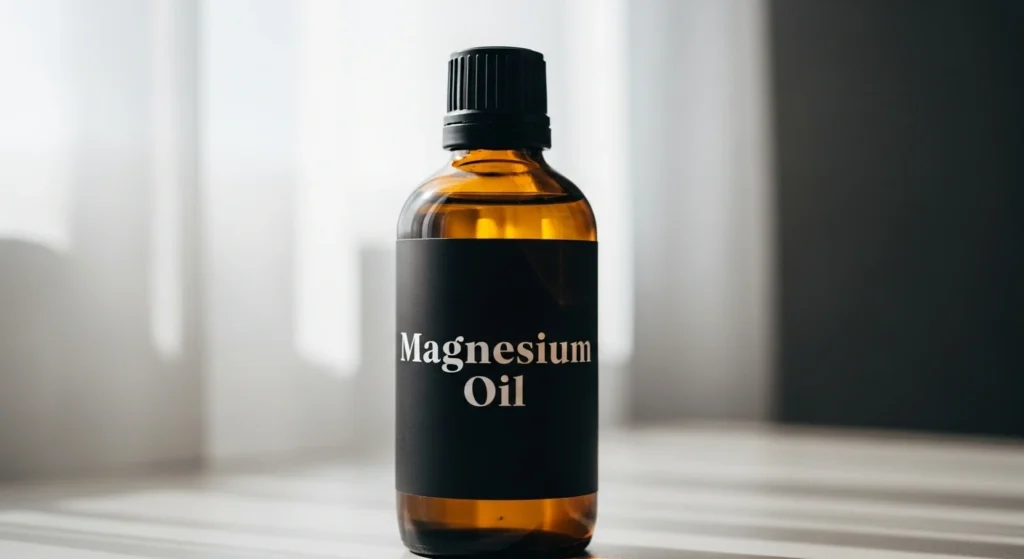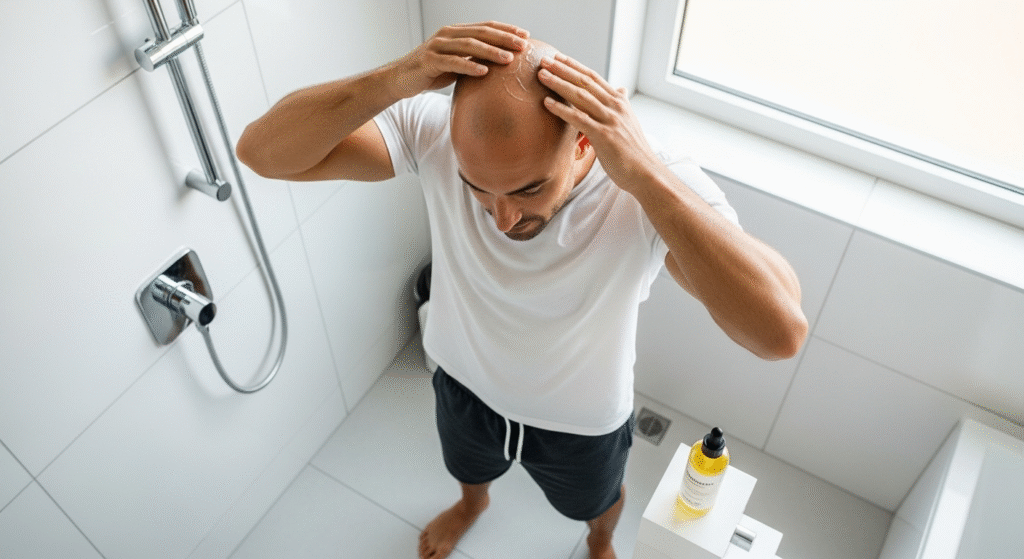What is Magnesium Oil?
Despite its name, magnesium oil isn’t actually an oil—it’s a concentrated solution of magnesium chloride flakes dissolved in water. When applied to the skin (topically), it’s referred to as transdermal magnesium. It often feels oily but leaves no greasy residue.
This delivery method is popular because it bypasses the digestive tract, delivering magnesium directly to the tissues, including the scalp.

How Magnesium Interacts with Scalp Health
Magnesium plays a key role in over 300 cellular processes in the body, including hair follicle function. Here’s how it helps:
- Reduces scalp inflammation: Chronic inflammation is a major contributor to hair follicle miniaturization.
- Improves blood circulation: Magnesium supports better oxygen and nutrient delivery to the scalp.
- Regulates calcium buildup: Excess calcium from hard water or product residue can clog follicles; magnesium helps restore mineral balance.
- Supports hormonal balance: It may lower cortisol (stress hormone) levels, which are linked to hair shedding.
Benefits of Magnesium Oil for Hair Loss
Applying magnesium oil directly to your scalp may offer the following hair-related benefits:
Reducing Scalp Inflammation & Follicle Irritation
Magnesium’s natural anti-inflammatory properties may help soothe irritated scalp conditions like dandruff, eczema, or seborrheic dermatitis, common triggers for hair fall.
Enhancing Circulation and Nutrient Delivery
Magnesium stimulates vasodilation, improving blood flow to hair follicles and helping nutrients like biotin and zinc reach where they’re needed most.
Supporting Protein Synthesis & Hormonal Balance
Hair is made of keratin, a protein that relies on magnesium for proper formation. Moreover, magnesium helps regulate hormones like DHT and cortisol, both involved in stress-induced or androgenic hair loss.
Preventing Mineral Buildup from Hard Water
Using hard water to wash your hair can cause calcium deposits on the scalp. Magnesium oil helps dissolve this buildup, leaving the follicles unclogged and more receptive to growth.
How to Use Magnesium Oil for Hair Loss
Choosing a Quality Product
- Look for pure magnesium chloride flakes sourced from the Zechstein Sea.
- Avoid products with added synthetic fragrances or fillers.
Or, make your own:
- Dissolve 1/2 cup magnesium flakes in 1/2 cup distilled water. Store in a spray bottle.
Step-by-Step Routine
- Do a patch test on your forearm to check for irritation.
- Apply to dry scalp—focus on thinning or itchy areas.
- Leave for 15–30 minutes (or overnight if tolerable).
- Rinse with a gentle, sulfate-free shampoo.
- Repeat 3–4 times per week.
Pro Tip: Mix with a carrier oil like jojoba or aloe vera gel to reduce the tingling sensation.
Frequency & Timeline Chart
| Week | Expected Outcome |
|---|---|
| 1–2 | Reduced itchiness, improved scalp comfort |
| 3–4 | Less hair shedding, improved texture |
| 6–8 | Visible signs of regrowth in some users |
| 12+ | Thicker strands, new baby hairs in hairline or crown |
[Image Suggestion: 12-week hair regrowth timeline with milestones]
Combining with Oral Magnesium
Topical magnesium works best when paired with an oral supplement (200–400 mg/day) for systemic support. Always consult a physician before adding supplements.
Risks, Limitations & Who Should Avoid It
Skin Irritation & Sensitivity
Some users experience a tingling or burning sensation. This can be minimized by diluting the oil or applying it on a damp scalp.
Avoid if you:
- Have broken skin or open wounds
- Are allergic to magnesium chloride
- Experience persistent discomfort

Absorption Limitations
There’s an ongoing debate about how well magnesium is absorbed through the skin. While some studies suggest benefits, others argue that oral magnesium may be more effective systemically.
Medical Precautions
Consult your doctor before use if:
- You are pregnant or breastfeeding
- You have kidney issues or a magnesium sensitivity
- You are currently on hair loss medications like minoxidil
FAQs
How long until I see results from magnesium oil?
Most users see improvement in scalp health in 2–4 weeks, with visible regrowth in 8–12 weeks.
Can I use magnesium oil with minoxidil?
Yes, but apply at different times of day to avoid irritation.
Is magnesium oil safe for color-treated or sensitive scalps?
Generally, yes, especially if diluted. Always patch test first.
What’s the best concentration or dosage?
A 1:1 ratio of flakes to distilled water is standard. Start with 1–2 sprays per area.
Should pregnant women use it?
Consult your OB-GYN before using any transdermal magnesium products during pregnancy.
Expert Recommendation & Next Steps
Magnesium oil is not a replacement for clinical hair loss treatments, but can be a powerful addition to a scalp care routine, especially if inflammation, buildup, or stress is contributing to thinning. For persistent hair loss or underlying causes like AGA, PCOS, or thyroid disorders, consult a certified trichologist or hair restoration specialist.
Want to know if magnesium oil can help your hair loss?
Book a personalized scalp consultation with Dr. Rana Irfan, an ABHRS and ISHRS certified surgeon in Islamabad today. Our clinic specializes in non-invasive and advanced hair restoration therapies, customized to your unique needs.
